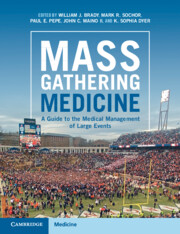Book contents
- Mass Gathering Medicine
- Mass Gathering Medicine
- Copyright page
- Dedication
- Contents
- Contributors
- Foreword
- Preface
- Chapter 1 An Introduction to Mass Gathering Medicine
- Chapter 2 Patient Care at Mass Gathering Events: Basic, Advanced, and Critical Care
- Chapter 3 Prediction of Medical Need and Event Risk Assessment at Mass Gathering Events
- Chapter 4 Medical Logistics and Operational Planning for Patient Care at Mass Gathering Events
- Chapter 5 Medical and Medical Support Staffing at Mass Gathering Events
- Chapter 6 Mass Gathering Medicine: Equipment and Planning Considerations
- Chapter 7 Incident Command System at Mass Gathering Events
- Chapter 8 Security and Other Nonmedical Logistical Support Issues at Mass Gathering Events
- Chapter 9 Understanding Local, State, and Federal Public Safety, Health Care, and Support Agencies
- Chapter 10 Common Themes and General Considerations across Mass Gathering Event Types
- Chapter 11 Mass Gathering Events: Youth, High School, Collegiate, Olympic, and Professional Sporting Events
- Chapter 12 Mass Gathering Events: Music Concerts and Festivals
- Chapter 13 Mass Gathering Events: Motor Sport Events
- Chapter 14 VIP and Executive Medicine Considerations at Mass Gathering Events
- Chapter 15 Mass Gathering Events: Community Events
- Chapter 16 Mass Gathering Events: Endurance Athletic Events
- Chapter 17 Mass Gathering Events: Extended Duration Events
- Chapter 18 At-Risk Populations within Mass Gathering Events
- Chapter 19 Crowd-Related Considerations at Mass Gathering Events: Management, Safety, and Dynamics
- Chapter 20 Civil Unrest and Terrorism Involving Mass Gathering Events
- Chapter 21 Impact of Weather and Climate Change on Mass Gathering Events
- Chapter 22 Occurrence of the Mass Casualty Incident at a Mass Gathering Event
- Chapter 23 Touring Medicine
- Chapter 24 Infectious Disease and Mass Gathering Medicine
- Chapter 25 Toxicology and Mass Gathering Medicine
- Chapter 26 Medicolegal Considerations in Mass Gathering Medicine
- Chapter 27 Business Considerations in Mass Gathering Medicine
- Index
- References
Chapter 5 - Medical and Medical Support Staffing at Mass Gathering Events
Published online by Cambridge University Press: 11 April 2024
- Mass Gathering Medicine
- Mass Gathering Medicine
- Copyright page
- Dedication
- Contents
- Contributors
- Foreword
- Preface
- Chapter 1 An Introduction to Mass Gathering Medicine
- Chapter 2 Patient Care at Mass Gathering Events: Basic, Advanced, and Critical Care
- Chapter 3 Prediction of Medical Need and Event Risk Assessment at Mass Gathering Events
- Chapter 4 Medical Logistics and Operational Planning for Patient Care at Mass Gathering Events
- Chapter 5 Medical and Medical Support Staffing at Mass Gathering Events
- Chapter 6 Mass Gathering Medicine: Equipment and Planning Considerations
- Chapter 7 Incident Command System at Mass Gathering Events
- Chapter 8 Security and Other Nonmedical Logistical Support Issues at Mass Gathering Events
- Chapter 9 Understanding Local, State, and Federal Public Safety, Health Care, and Support Agencies
- Chapter 10 Common Themes and General Considerations across Mass Gathering Event Types
- Chapter 11 Mass Gathering Events: Youth, High School, Collegiate, Olympic, and Professional Sporting Events
- Chapter 12 Mass Gathering Events: Music Concerts and Festivals
- Chapter 13 Mass Gathering Events: Motor Sport Events
- Chapter 14 VIP and Executive Medicine Considerations at Mass Gathering Events
- Chapter 15 Mass Gathering Events: Community Events
- Chapter 16 Mass Gathering Events: Endurance Athletic Events
- Chapter 17 Mass Gathering Events: Extended Duration Events
- Chapter 18 At-Risk Populations within Mass Gathering Events
- Chapter 19 Crowd-Related Considerations at Mass Gathering Events: Management, Safety, and Dynamics
- Chapter 20 Civil Unrest and Terrorism Involving Mass Gathering Events
- Chapter 21 Impact of Weather and Climate Change on Mass Gathering Events
- Chapter 22 Occurrence of the Mass Casualty Incident at a Mass Gathering Event
- Chapter 23 Touring Medicine
- Chapter 24 Infectious Disease and Mass Gathering Medicine
- Chapter 25 Toxicology and Mass Gathering Medicine
- Chapter 26 Medicolegal Considerations in Mass Gathering Medicine
- Chapter 27 Business Considerations in Mass Gathering Medicine
- Index
- References
Summary
One of the most imperative objectives in planning for medical services at a mass gathering event is determining the number and type of staff members needed. Mass gathering events are typically interdisciplinary in their medical staffing, with prehospital providers, nursing staff, and physicians working together to deliver high quality medical care. In addition to numbers and types of medical staff, planning for adequate support staff to fill logistics, management, and administrative roles is key to the success of the medical plan. Each staff member must also be trained and credentialled and be properly prepared to fill their role. This chapter reviews key considerations when planning staffing for medical events, including elements such as provider training and mindset, staffing models, and special considerations.
- Type
- Chapter
- Information
- Mass Gathering MedicineA Guide to the Medical Management of Large Events, pp. 57 - 73Publisher: Cambridge University PressPrint publication year: 2024



